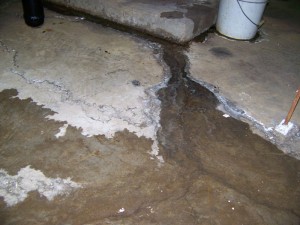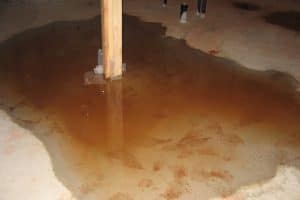A leaking basement wall is a homeowner’s nightmare that can lead to a host of problems, from structural damage to mold growth. Basement walls, being in direct contact with the surrounding soil and groundwater, are particularly vulnerable to water infiltration. Understanding the causes, prevention methods, and solutions for leaking basement walls is crucial for maintaining a dry and structurally sound home.
Causes of Leaking Basement Walls
1. Hydrostatic Pressure:
Hydrostatic pressure is a significant cause of basement wall leaks. It occurs when the soil surrounding the foundation becomes oversaturated
2. Poor Construction:
The quality of construction plays a pivotal role in preventing basement wall leaks. Inadequate construction techniques, the use of subpar materials, or shortcuts taken during the building process can result in basement walls that lack the necessary waterproofing features. These walls are more susceptible to water penetration and leaks. To avoid this, it’s crucial for builders to use quality materials, employ proper techniques, and ensure that adequate basement waterproofing and measures are in place during construction.
3. Cracks and Gaps:
Basement walls are exposed to various stresses over time, such as natural settling of the foundation, temperature fluctuations, and soil movement. These environmental factors can cause the development of cracks and gaps in the walls. Even small openings can serve as entry points for water, allowing it to infiltrate the interior of the basement. If left untreated, these cracks can widen, leading to more severe leaks.
4. Inadequate Drainage:
A critical aspect of maintaining a dry basement is proper water management around the foundation. Several factors can contribute to poor drainage in wet basements and exacerbate the risk of leaks:
- Improper Grading: The ground around the foundation should be graded away from the house to ensure that water flows away from the structure. Inadequate grading can lead to water collecting near the basement walls, increasing the likelihood of leaks.
- Clogged or Malfunctioning Gutters: Gutters and downspouts are designed to collect and channel rainwater away from the roof and foundation. When these systems become clogged with debris or are not functioning correctly, water can overflow and cascade down the walls, causing damage and potential leaks.
- Lack of Proper Drainage Systems: Installing proper drainage systems, such as French drains or sump pumps, can effectively manage groundwater around the foundation. Without these systems, hydrostatic pressure can build up, leading to water infiltration through basement walls.
By addressing these causes and implementing appropriate prevention measures, homeowners can significantly reduce the risk of basement wall leaks. Remember that proactive measures are often more cost-effective and less disruptive than dealing with the consequences of a leaky basement.
Prevention Methods
1. Proper Landscaping:
Ensuring proper landscaping and grading around the front foundation wall is a fundamental step in preventing basement wall leaks. Here’s what you can do:
- Grade Away from the House: Ensure that the ground around your home’s foundation slopes away from the house. This helps to direct rainwater and groundwater away from the basement walls. If the slope is inadequate, water may accumulate near the foundation, increasing the risk of leaks.
- Install Drainage Swales: In cases where the natural landscape does not allow for proper grading, consider installing drainage swales or channels that guide water away from the foundation. These can be lined with gravel or other suitable materials to facilitate efficient water flow.
2. Gutter Maintenance:
Properly functioning gutters and downspouts are crucial for keeping water away from your basement floors and walls. Follow these guidelines:
- Regular Cleaning: Clean your gutters and downspouts at least twice a year, or more frequently if you have trees near your home. Leaves, debris, and dirt can clog the system, causing water to overflow and potentially damage the walls.
- Install Gutter Guards: Gutter guards are designed to keep leaves and debris out of your gutters while allowing water to flow freely. Installing gutter guards can reduce the frequency of cleaning and ensure efficient water drainage.
- Gutter Extensions: Consider adding gutter extensions or downspout extensions to direct rainwater farther away from the foundation. These extensions can be designed to release water at a safe distance from your home.
3. Waterproofing:
Waterproofing your basement walls during construction or renovation is a proactive measure that can provide long-term protection. Here are some top basement waterproofing contractor options:
- Waterproof Coatings: Apply waterproof coatings or sealants to the interior or exterior surfaces of the basement walls. These coatings create a barrier that prevents water from penetrating the walls.
- Waterproof Membranes: Waterproof membranes, often made of materials like asphalt-modified polyurethane, are applied to the exterior of the foundation walls during construction. They provide an additional layer of protection against water infiltration.
- Drainage Boards: Install drainage boards on the exterior of basement walls. These plastic or composite panels help divert water away from the walls and toward drainage systems, reducing the risk of leaks.
4. Foundation Drainage Systems:
Installing a concrete foundation drainage system is a proactive approach to managing groundwater and preventing hydrostatic pressure buildup:
- French Drains: A French drain is a trench filled with gravel or similar material that directs water away from the foundation. It can be placed alongside the exterior walls and is designed to capture and channel water to a safe location.
- Sump Pumps: A sump pump is a device that collects water from the interior drainage system and pumps it out and away from the foundation. It’s an effective solution for controlling rising groundwater levels and reducing hydrostatic pressure.
By implementing these prevention methods, homeowners can significantly reduce the risk of basement wall leaks. Proactive maintenance and waterproofing measures help safeguard your basement, preserving its structural integrity and ensuring a dry and usable space.
Solutions for Leaking Basement Walls
1. Crack Injection:
For small cracks in the basement walls, crack injection is an effective solution. This method involves injecting epoxy or polyurethane materials into the cracks to seal them and prevent further water infiltration. Here’s how it works:
- Epoxy Injection: Epoxy is a two-part adhesive that, when mixed and injected into the crack, hardens to create a strong and waterproof seal. Epoxy is ideal for cracks that are not actively leaking and are relatively narrow.
- Polyurethane Injection: Polyurethane foam is another suitable material for sealing cracks. It expands upon contact with water, effectively filling the crack and creating a watertight seal. Polyurethane is a good choice for actively leaking cracks.
2. Interior Drainage System:
An interior drainage system is a more involved solution for managing water from heavy rain that has infiltrated the basement. This method involves creating a channel along the perimeter of the basement floor to collect water and direct it to a sump pump. The sump pump then removes the collected water from the basement. Here’s how it works:
- Trench or Drainage Channel: A trench or drainage channel is installed along the interior perimeter of the basement floor. This channel collects water and directs it to the sump pump.
- Sump Pump: The sump pump is a device that automatically removes the collected water from the basement and pumps it to a safe location, such as a storm drain or a dry well. Sump pumps are essential for managing rising groundwater levels and preventing leaks.
3. Exterior Waterproofing:
In cases of severe leakage and when other solutions are insufficient, exterior waterproofing is a comprehensive approach to protect the foundation repair the basement walls from water infiltration. This method involves excavating the soil around the foundation and applying various protective measures:
- Excavation: The area around the foundation is excavated to expose the exterior of the basement walls.
- Waterproof Membranes: Waterproof membranes or coatings are applied to the exterior surface of the basement walls to create a strong barrier against water infiltration.
- Drainage Boards: Drainage boards or panels may be installed to facilitate water drainage away from the walls.
- Backfilling: After the waterproofing materials are in place, the excavated area is backfilled with clean, well-compacted soil.
4. Professional Assistance:
When dealing with persistent leaks, or extensive damage, or if you are unsure about the best course of action, it’s advisable to seek the expertise of a professional waterproofing contractor. These professionals can provide the following services:
- Assessment: A thorough assessment of the basement’s condition and the extent of the water infiltration issues.
- Recommendations: Professional contractors can recommend the most appropriate solutions tailored to your specific situation.
- Effective Repair: Professional contractors have the skills and experience to perform the necessary repairs or installations with a high degree of precision.
In summary, the choice of solution for dealing with leaking basement walls depends on the severity of the issue. For minor cracks, DIY solutions like crack injection may suffice. Interior drainage systems are ideal for managing ongoing water intrusion. In cases of severe leakage, exterior waterproofing can provide comprehensive protection and keep water throughout. Lastly, professional assistance is recommended for complex or persistent issues, ensuring a thorough and effective repair. Addressing leaking basement walls promptly is essential to protect your home’s structural integrity and maintain a dry and safe living environment
Securing Your Home and Peace of Mind: The Imperative of Dealing with Leaking Basement Walls
Dealing with leaking basement walls is a crucial endeavor for homeowners looking to protect their investments and ensure a safe and comfortable living environment. Understanding the causes, prevention methods, and solutions for basement wall leaks is key to tackling this issue effectively.
Hydrostatic pressure, poor construction, cracks, and inadequate drainage are among the primary culprits behind basement wall leaks. By
Preventive measures such as proper landscaping, regular gutter maintenance, waterproofing during construction, and the installation of foundation drainage systems play a vital role in keeping basement walls dry. Proactive maintenance and these prevention methods can save you from the stress and expense of dealing with water damage in the long run.
When leaks do occur, solutions like crack injection, interior drainage systems, and exterior waterproofing can be applied to rectify the problem. For complex or persistent issues, enlisting the expertise of a professional waterproofing contractor is a wise choice.
In conclusion, maintaining a dry and structurally sound basement is essential not only for the safety of your home but also for your peace of mind. By understanding the causes of basement leaks, implementing preventive measures, and being aware of effective solutions, homeowners can protect their homes and create a secure and comfortable living environment. Don’t wait for basement leaks to become a bigger problem; take action to safeguard your home today.

Everdry Waterproofing is one of the nation’s largest Basement waterproofing companies. Everdry specializes in basement waterproofing, crawlspace waterproofing, foundation repair and basement ventilation. Our patented, safe and 100% effective waterproofing method can be used on foundations consisting of poured concrete, block, brick, stone, red clay tile plus crawlspaces and slabs. We have been in business for more than 40 years and have over 85,000 “RAVING FANS.”
